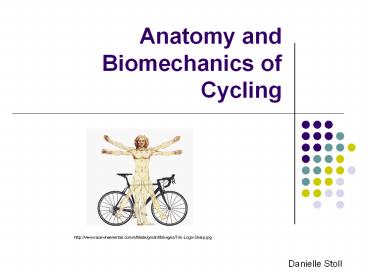Anatomy and Biomechanics of Cycling - PowerPoint PPT Presentation
1 / 24
Title: Anatomy and Biomechanics of Cycling
1
Anatomy and Biomechanics of Cycling
http//www.racewheelrental.com/affiliate/greshfiti
mages/Tim-Logo-Sharp.jpg
Danielle Stoll
2
Overview
- Anatomy
- Muscles
- Bones
- The Pedal Stroke and forces
- Static Equilibrium of a Cyclist
- Joint Reaction Forces
3
Introduction
- Biomechanics is applying mechanical principles to
living organisms - Further our understanding of how the human body
reacts during movement - Helps identify reasons for injuries
- Helps athletes to maximize muscle power
4
Lower Body Anatomy
Angle from horizontal (deg)
5
Lower Body Anatomy
Angle from vertical (deg)
6
Changes in Seat Height
- Greater saddle height allows cyclists to pedal
with greater ease especially at high work loads - Changing saddle height alters
- joint angles of muscles
- lengths of muscles
- amount of force a muscle can produce
- Optimal saddle height 105 107 of leg length
7
Changes in Seat Height
8
Bones of the Lower Body
- Tibia is the shin bone
- Fibula attaches to the Tibia on the outside (or
laterally) - tarsals are the ankle bones
- Phalanges are the toes
Right Leg
http//www.web-books.com/eLibrary/Medicine/Physiol
ogy/Skeletal/lower_extremity.jpg
9
2-D Model of Cyclist Leg
- Human Leg
- 3 rigid link system
- Hip joint
- Knee joint
- Ankle joint
10
Joints
- Knee joint
- Hinge joint
- Allows for slight internal and external roatation
- Ankle joint
- Simple pin joint
- Foot
- 26 different bones
- Can absorb shock
11
Movement of the Legs
- Power phase 0-180
- Recovery phase 180 -360
- At comfortable seat height
- ROM of thigh 45 from max flexion to max
extension - ROM of knee 75 from max flexion to max
extension - ROM ankle 20 between max dorsiflexion and max
planterflexion - Hip joint never moves into full extension
- Only full extension when thigh moves behind
center of trunk
(A) minimum hip flexion (B) maximum hip
flexion (C) maximum knee extension (D) maximum
knee flexion
12
Bones of the Lower Body
http//www.lollylegs.com/images/pelvislateral.jpg
- The acetabulum articulates with the femoral head
- The hip joint is a ball and socket joint
13
The Sit Bones
- Sit bones Ischial Tuberosity
http//www.lollylegs.com/images/pelvisposterior.jp
g
14
Gender Differences in the Pelvis
- Figure A shows a typical male pelvis
- Notice the V shape at the pubic arch
- Narrower Ischial tuberoisity
- Figure B shows female pelvis
- Notice the U shape at the pubic arch
- Wider ischial tuberosity
FEMALE
MALE
15
The Pedal Stroke
Ankling Angle (deg)
- Location of foot during a pedal stroke
- (A) accepted literature
- (B) study of 7 elite riders
- Ankling angle versus crank angle of 7 elite
riders
16
Pedal Reaction Forces
- Pedal Reaction Forces- when a foot applies a
force to a pedal, it is met with a reaction force
equal and opposite magnitude - Peak pedal force
- Normal force Fz60 bodyweight or 350 N for
avgerage cyclist - Shear forces
- Medial and lateral (Fx)
- Anterior and Posterior (Fy)
17
Pedal Reaction Forces
- Resultant Pedal Reaction Force for right lower
extremity - Force vector in front Center of Rotation (COR) of
hiphip extensor muscles activated - Force vector behind (COR) for kneeknee extensor
muscle activated - Force vector in front of ankle joint plantar
flexor muscles activated
18
Pedal Reaction Forces
- Pedal Reaction Forces
- Does not exceed body weight unless standing
- Resultant force vector changes magnitude and
direction throughout pedal stroke
Pedal Reaction Force
90 180 270 360
Pedal Cycle (degrees)
19
Pressure Distribution on Shoe
- Almost all pressure us located under big toe
- Little pressure exerted at arch and heal
- Pattern of pressure distribution on the sole of
the shoe
20
Static Equilibrium of a Cyclist
- A cyclist balancing on the cycle
- C cyclist propelling bike forward
- Major forces
- G1 and G2 are ground reaction forces at front and
rear wheels - P1 and P2 left and right pedal forces
21
Static Equilibrium of a Cyclist
- Wr force due to weight of rider
- Wb is the weight of the cycle
- R is drag due to air resistance
- H is the force exerted by hands of handle bars
- G1G2P1P2WrWbH
22
Joint Reaction Forces
- Power phase
- compressive joint reaction force by distal end of
femur on tibial plateau - Anteriorly directed joint reaction force during
the power phase - Laterally directed joint reaction force at the
knee - Peak joint reaction forces have highest values at
90 of pedaling cycle
http//www.treehugger.com/Norwegian20cyclist.jpg
23
References
- Burke, Edmund R. Science of Cycling. Human
Kinetics, 1986. - (2002). Cycling Styles Techniques. Retrieved
February 17, 2009, from North Lanarkshire
Council Web site http//www.northlan.gov.uk/lei
sureandtourism/sportsactivities/cycling/cycling
styles andtechniques.html - Gregor, Robert J., and Francecso Conconi. Road
Cycling - Hanbook of Sports Medicine and
Science. OxfordMalden,Mass Blackwell Science,
2000. - Lee, C. (2008). Updates Log. Retrieved February
17, 2009, from Calvin Lee Web site
http//www.risingpianofire.com/updates.htm - Potter, J. J., J. L. Sauer, et al. (2008).
"Gender differences in bicycle saddle pressure
distribution during seated cycling." Medicine
and Science in Sports and Exercise 40(6)
1126-1134 - (2009). Semimembranosis. Retrieved February 17,
2009, from Club Physio Plus Web site
http//www.clubphysioplus.com/Myofasial_stretches
/semimemb.htm - University of Southern Calafornia. Retrieved
February 17, 2009, from Pelvic Anatomy Web site
http//radiology.usc.edu/Presentations/SaddlePros
thesis/PAGE2_ANAT_FINAL2.HTM - Wilson, C. and T. R. Bush (2007). "Interface
forces on the seat during a cycling activity."
Clinical Biomechanics 22(9) 1017-1023.
24
Muscle Activity
- Peak muscle activity during pedal stroke (0 is
top) - Gluteus Maximus 55
- Rectus Femoris drops off at 90
- Soleus and Gastrocnemius just before 90
- Gastrocnemius peaks at an average of 107 and
ends at 270 - Hamstrings active during entire down stroke
(power phase) - Semimembranosus Semitendinosus 0-90 peaks
at 90 - Quadriceps activity ceases at 90































